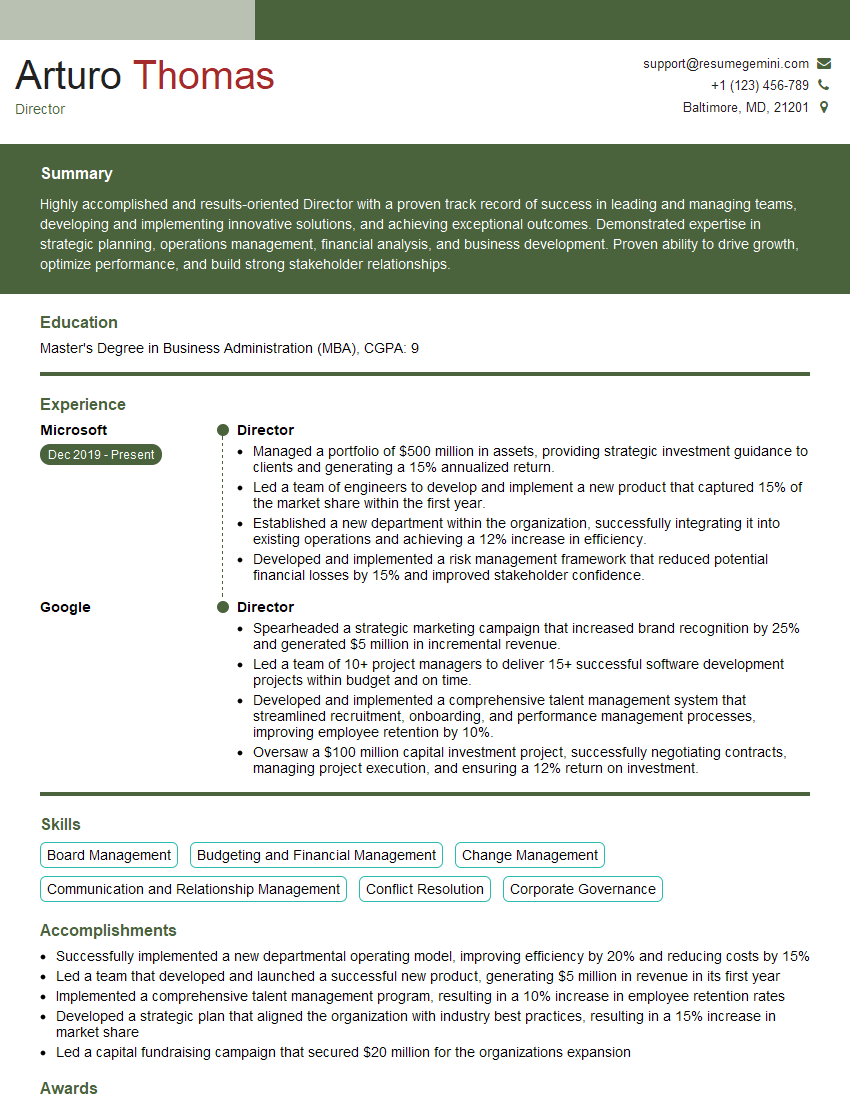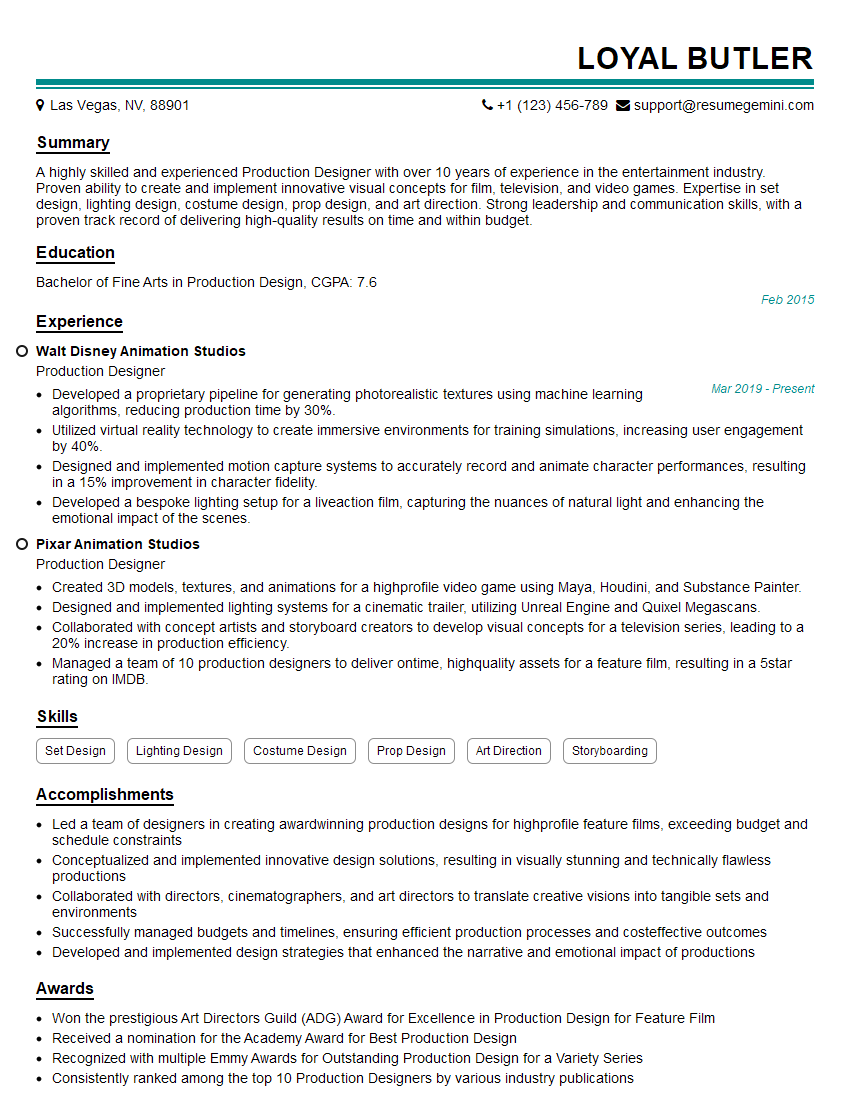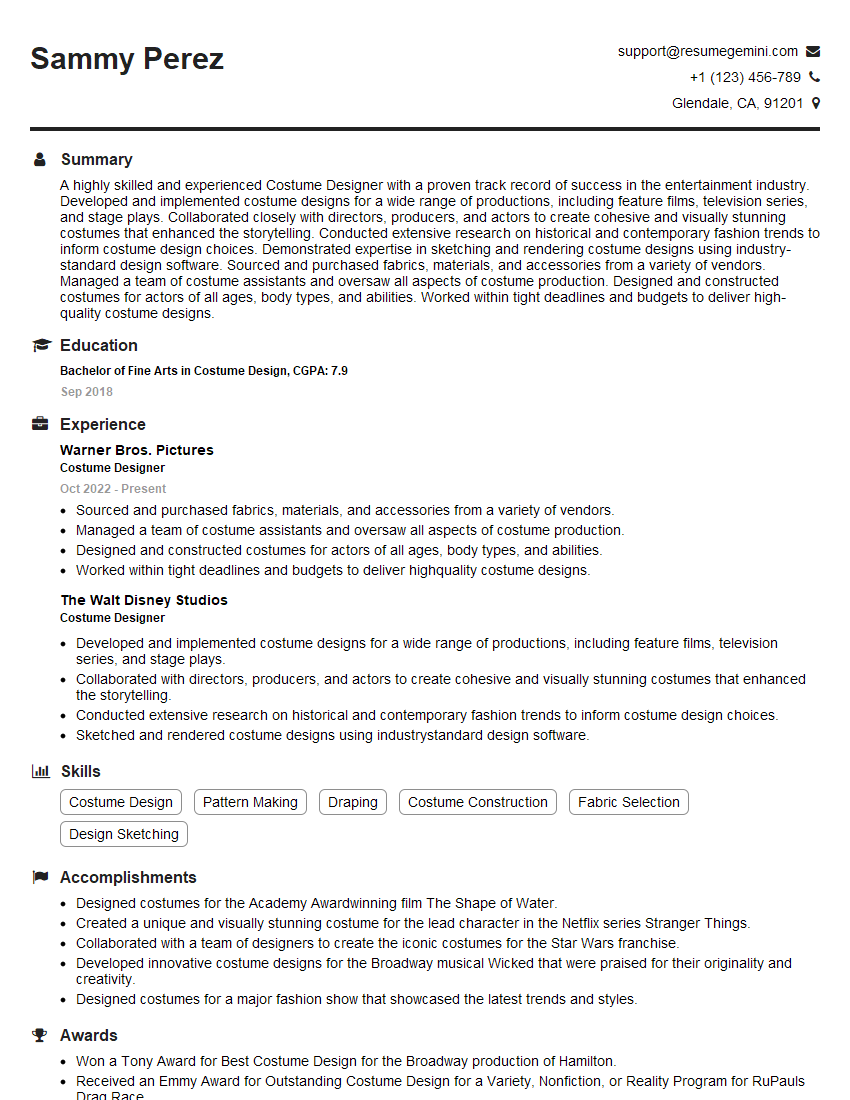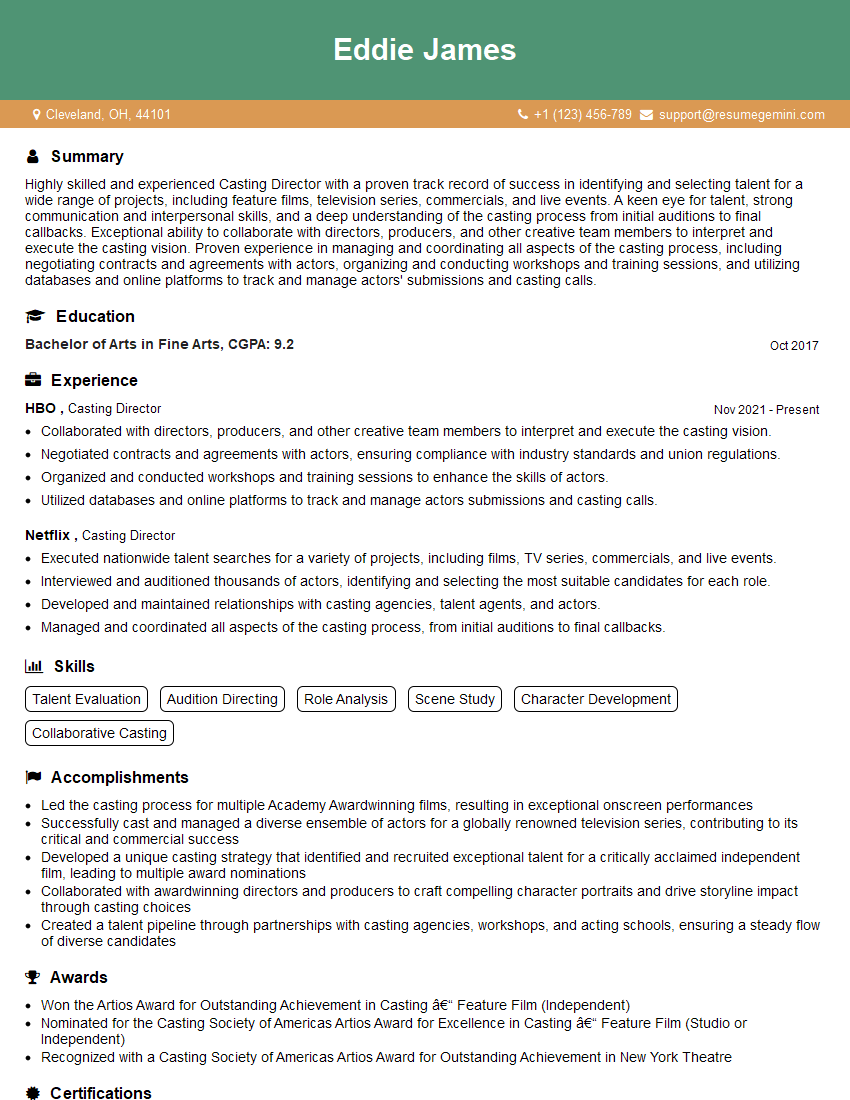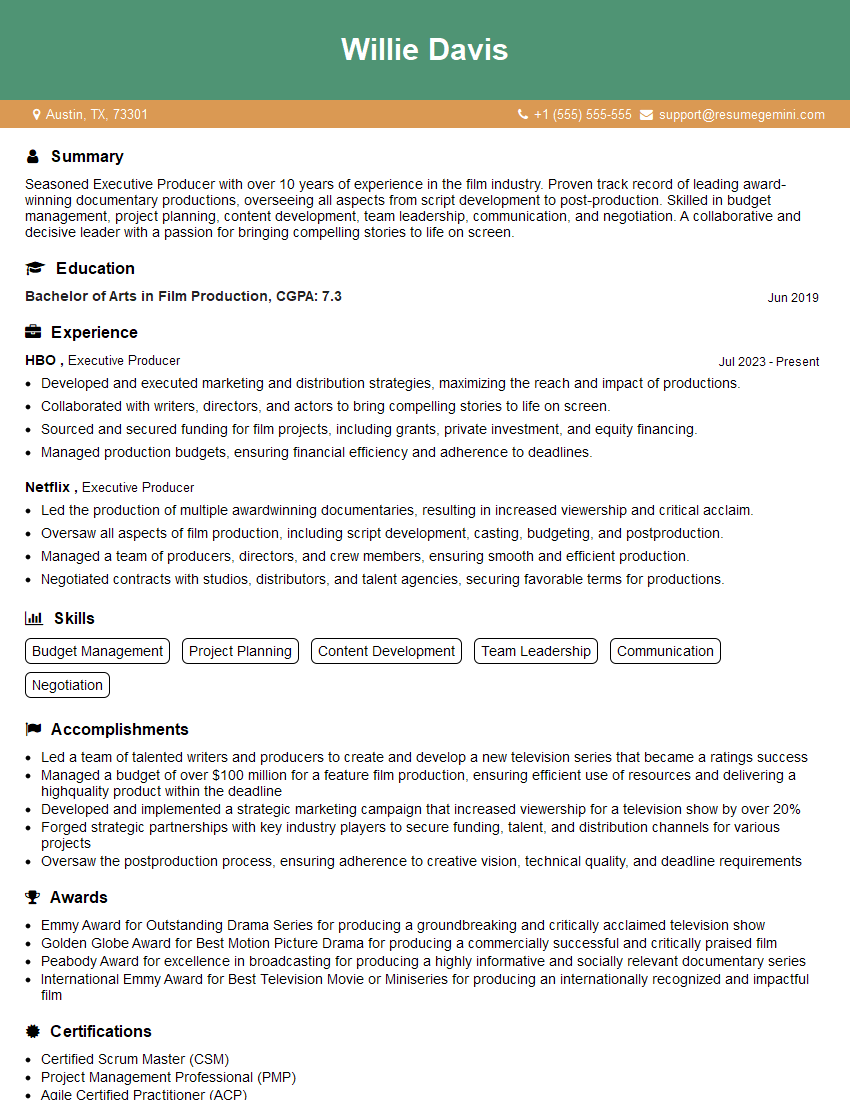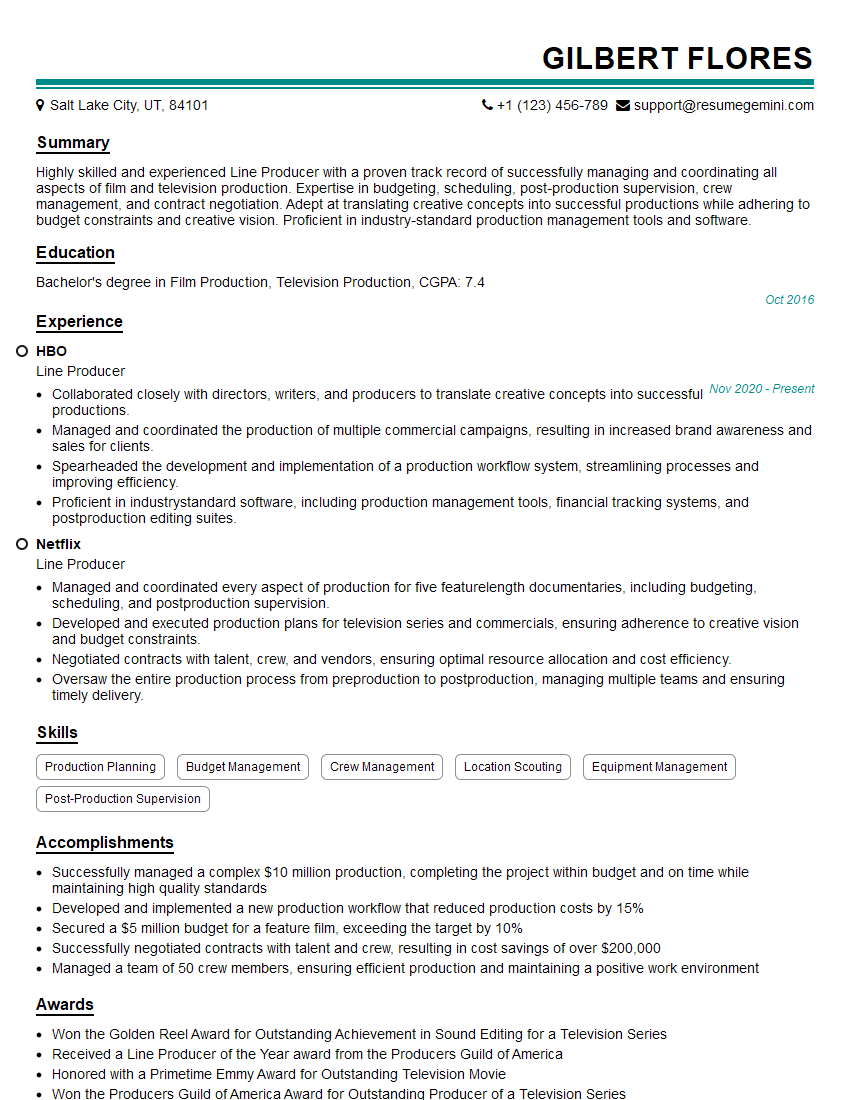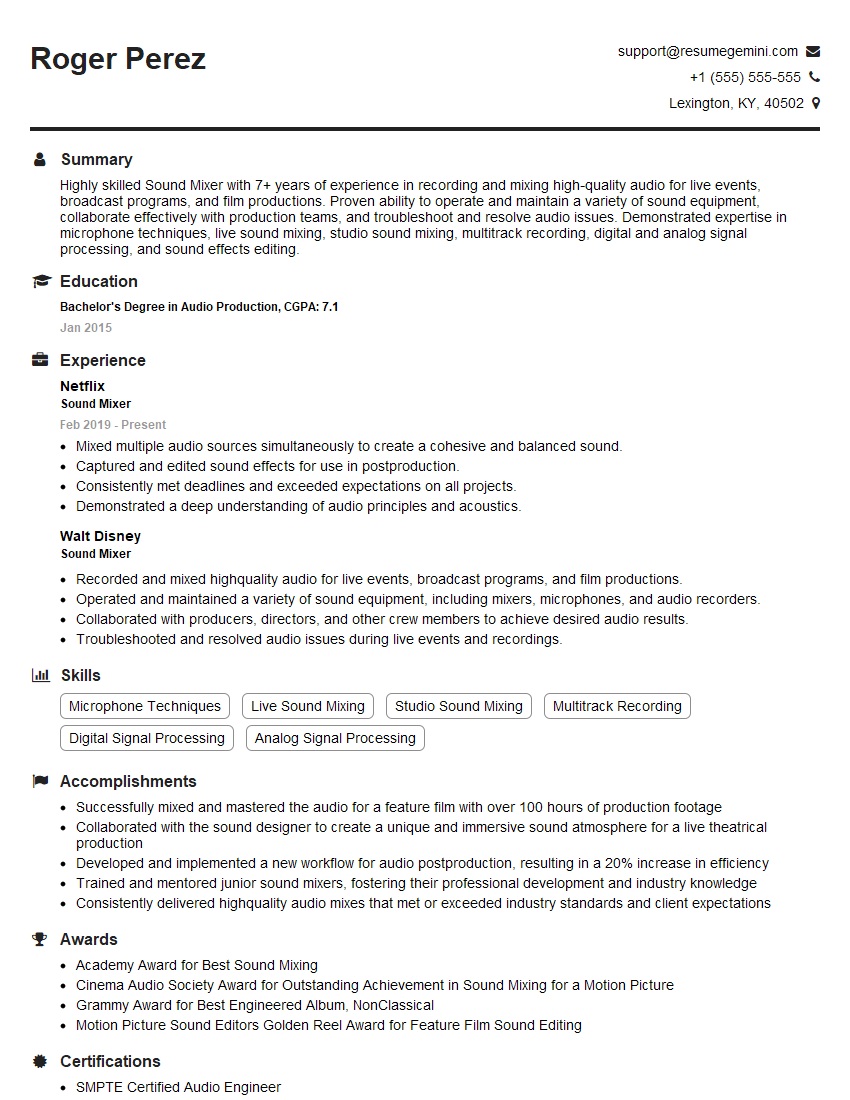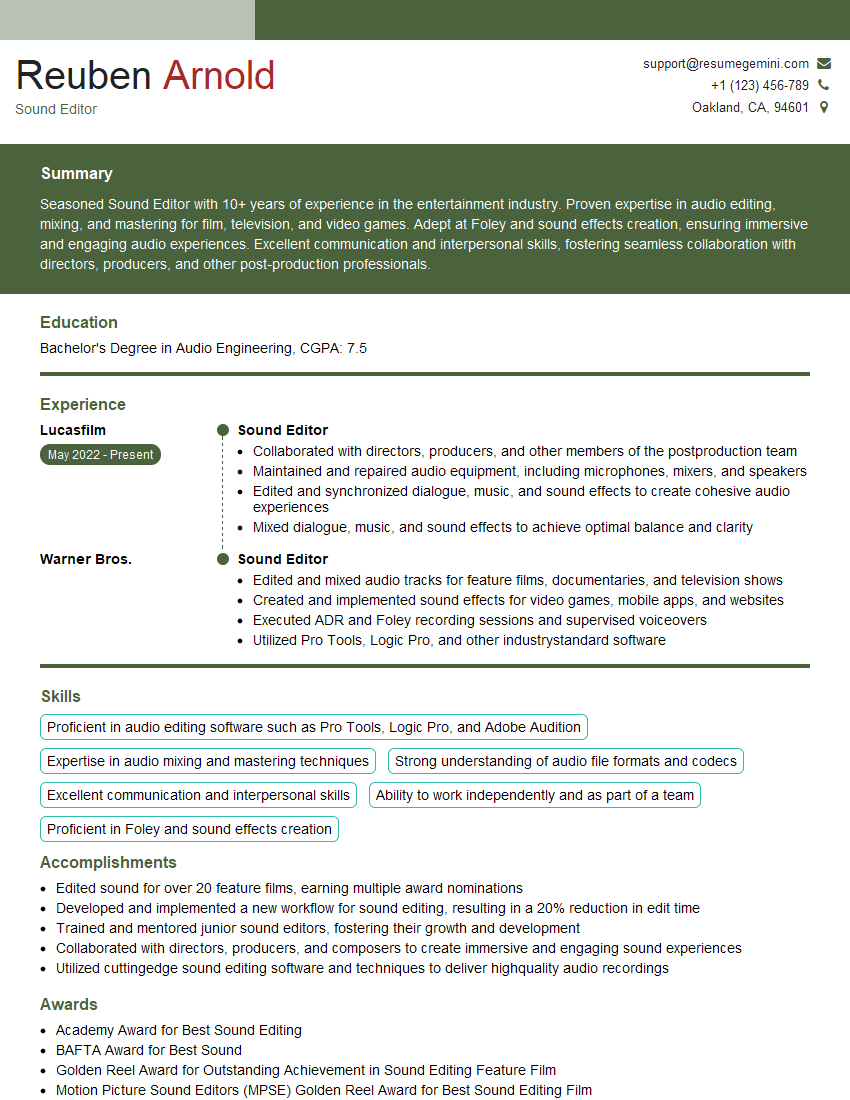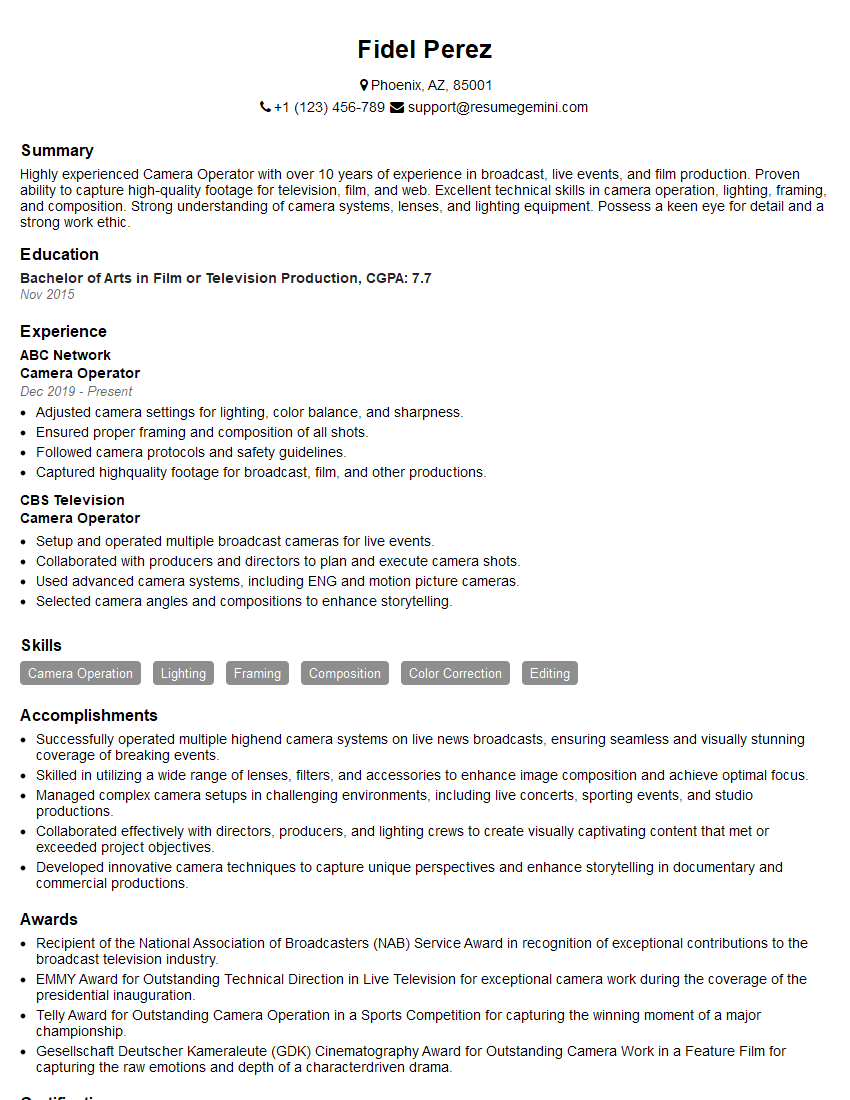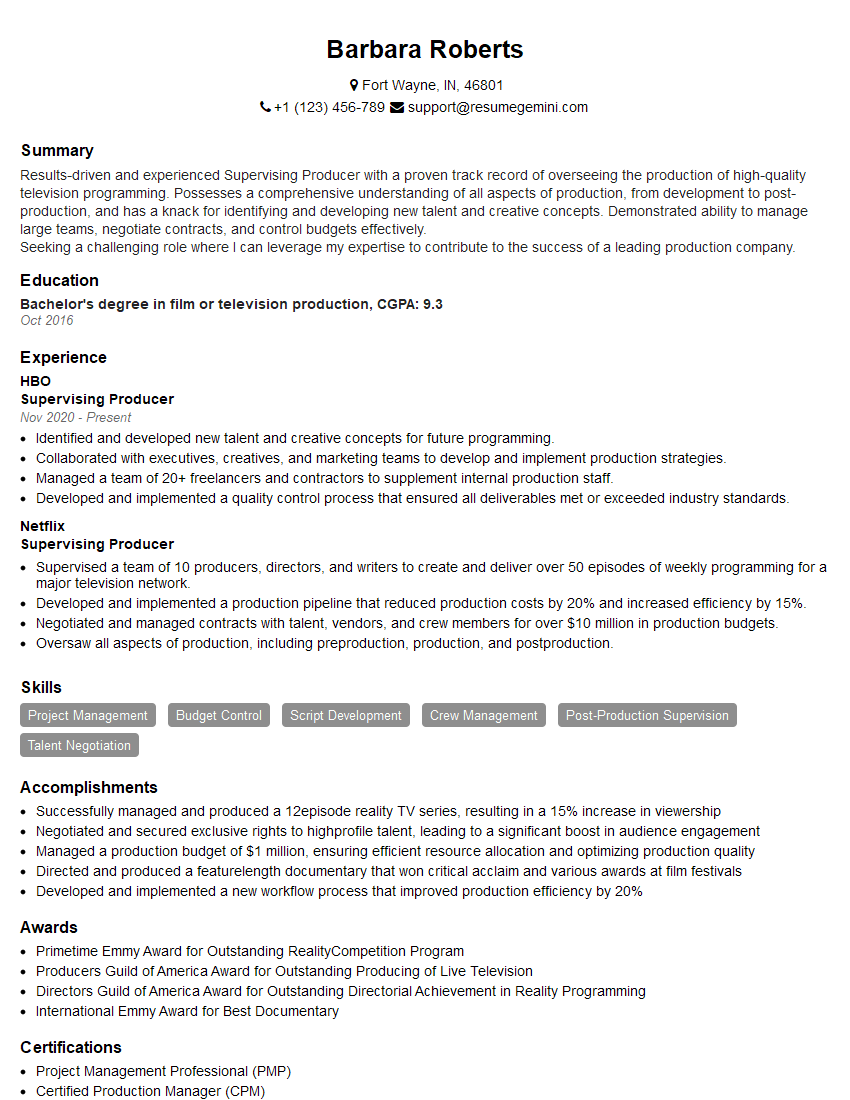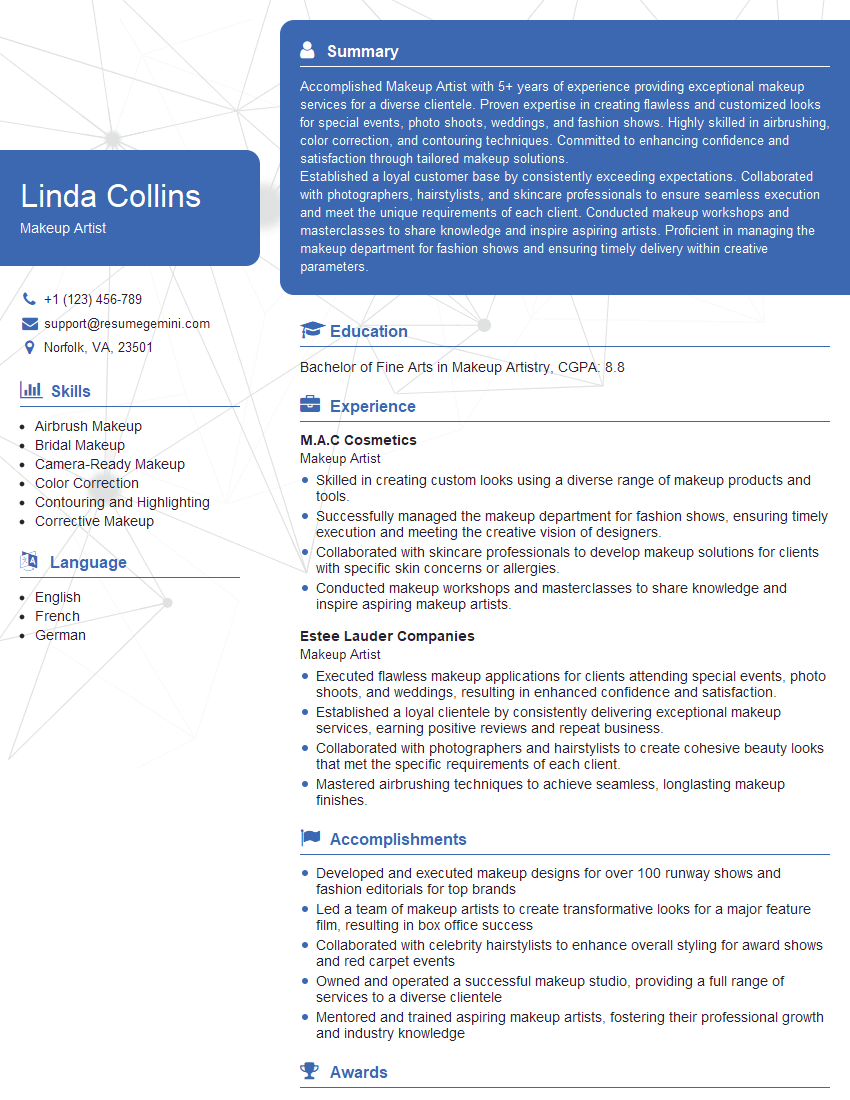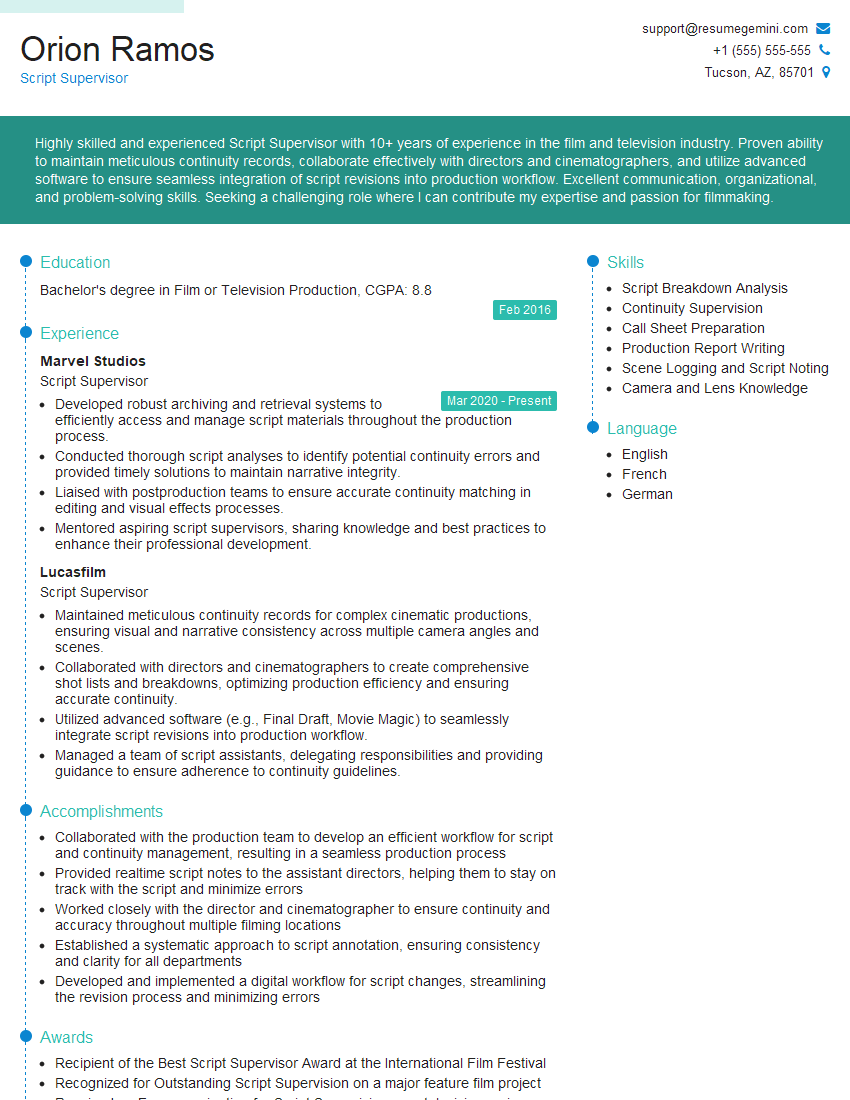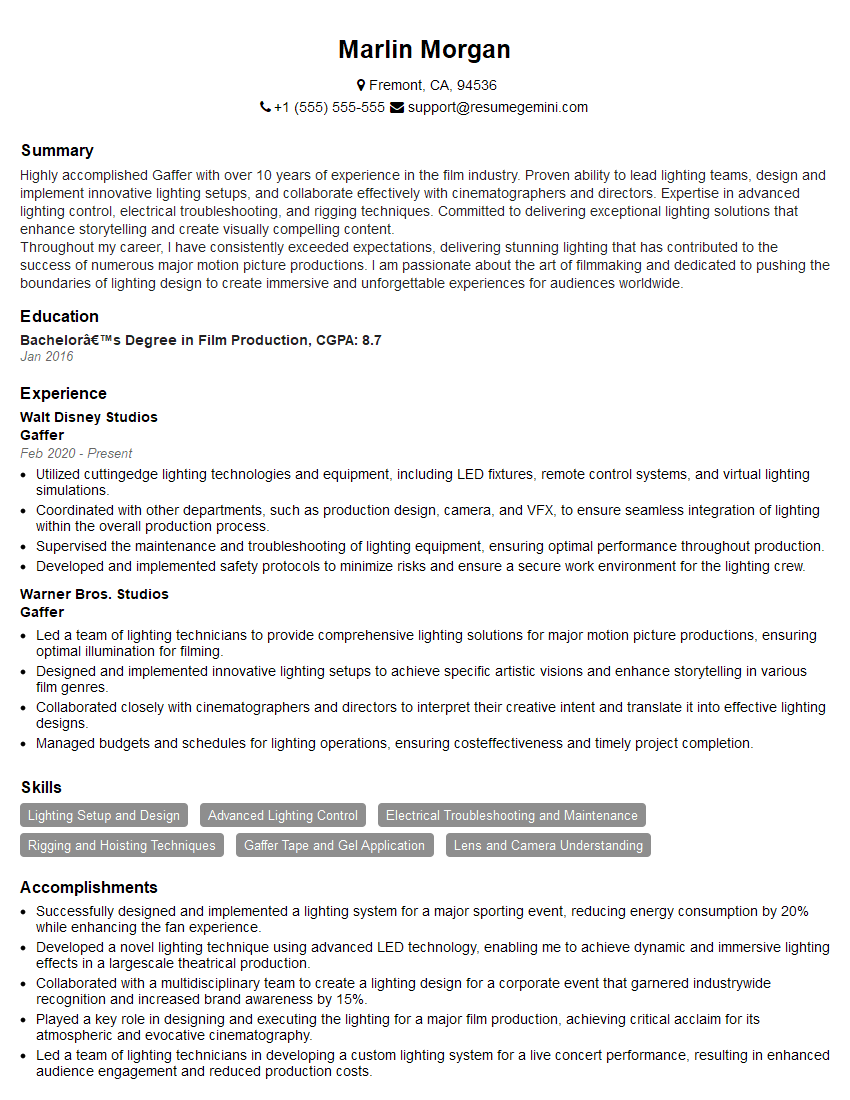Preparation is the key to success in any interview. In this post, we’ll explore crucial Episodic Television Production interview questions and equip you with strategies to craft impactful answers. Whether you’re a beginner or a pro, these tips will elevate your preparation.
Questions Asked in Episodic Television Production Interview
Q 1. Explain your experience with various episodic television production workflows.
My experience spans various episodic television workflows, from traditional studio-based multi-camera setups to complex, location-heavy single-camera productions. I’ve worked on both half-hour sitcoms employing a multi-camera setup with a live audience, where the efficiency of a tightly-choreographed shoot is paramount, and hour-long dramas utilizing a single-camera approach, demanding meticulous planning and shot composition to build narrative tension. I’m equally comfortable with documentary-style shoots, employing handheld cameras for a more immersive feel, and more stylized productions incorporating complex visual effects.
- Multi-camera sitcoms: Think of the rapid-fire dialogue and precision timing required for a show like Friends. This necessitates rigorous rehearsals, clear communication with the cast, and efficient camera blocking.
- Single-camera dramas: Imagine the nuanced storytelling in a show like Breaking Bad. This demands a strong understanding of visual storytelling, careful shot selection, and a robust post-production workflow to weave the narrative together.
- Hybrid approaches: Many shows blend these techniques, leveraging multi-camera for specific scenes, like establishing shots, and single-camera for more intimate moments, enhancing narrative versatility.
Q 2. Describe your experience managing budgets and schedules in episodic television production.
Budget and schedule management in episodic television is a critical skill, requiring meticulous planning and proactive problem-solving. My approach involves developing detailed budgets that account for every aspect of production, from pre-production costs (script development, location scouting) to post-production (editing, sound mixing, VFX). I use project management software to track expenses and ensure we stay within allocated resources. Similarly, schedules are meticulously crafted, taking into account potential delays, incorporating contingency plans, and consistently monitoring progress to stay on track. I’ve successfully managed productions with budgets ranging from $500,000 to $5 million per episode, always focusing on maximizing efficiency and value for money.
For instance, on a recent project, we identified a potential budget overrun on set dressing. By creatively re-purposing existing props and collaborating with the art department, we successfully avoided any additional costs without compromising visual quality. This required clear communication, proactive negotiation and a focus on efficient resource management.
Q 3. How do you handle unexpected challenges and setbacks during production?
Unexpected challenges are inevitable in episodic television production. My approach is to stay calm, assess the situation thoroughly, and implement a structured problem-solving strategy. This involves:
- Identifying the problem: Clearly define the issue, its impact on the schedule and budget, and potential consequences.
- Brainstorming solutions: Collaborate with the team to generate a range of potential solutions, prioritizing those that minimize disruption.
- Evaluating options: Assess each solution’s feasibility, cost implications, and potential risks.
- Implementing the best solution: Once a solution is chosen, ensure clear communication across all departments and effectively execute the plan.
- Documenting the process: Maintain records of the issue, the chosen solution, and its outcomes. This helps prevent similar challenges in the future.
For example, during a night shoot, we experienced a sudden power outage. Instead of panicking, we quickly switched to backup generators, informed the cast and crew, and adjusted the schedule to minimize downtime. We documented the incident, implemented checks on generator maintenance, and learned valuable lessons about preparedness for future unforeseen circumstances.
Q 4. What is your experience with different shooting styles (single-camera, multi-camera)?
I’m proficient in both single-camera and multi-camera shooting styles, understanding the unique strengths and challenges of each. Multi-camera setups are efficient for sitcoms and live shows, requiring precise blocking and camera operation, while single-camera setups provide greater flexibility for dramatic storytelling, allowing for diverse angles and creative shot compositions.
- Multi-camera: This style excels in capturing live performances and quick-paced dialogue, with efficiency prioritized. It requires a thorough understanding of staging, camera placement, and audience interaction.
- Single-camera: This offers greater creative control, allowing for varied camera angles, intricate shots, and a more cinematic look. It demands meticulous planning, detailed storyboards, and skilled camera operators.
I’ve successfully managed projects using both methods and adapted to blend them for optimal results, creating a visual richness that meets the demands of the narrative.
Q 5. Describe your proficiency in post-production processes, including editing and sound design.
My post-production experience encompasses all aspects, from editorial and sound design to color grading and visual effects. In editing, I’m adept at assembling scenes, crafting a narrative flow, and creating a compelling rhythm. My sound design skills include dialogue editing, sound effects integration, and music selection, ensuring a high-quality audio experience. I’m familiar with industry-standard software such as Avid Media Composer, Adobe Premiere Pro, and Pro Tools, and I collaborate closely with editors, sound designers, and VFX artists to ensure seamless integration.
For example, on a recent drama, I worked closely with the editor to create a suspenseful scene using sound design and editing techniques. We used specific sound effects and musical cues to enhance the tension and build towards a climactic moment. This integrated approach to post-production is crucial for establishing a cohesive tone and enhancing the narrative impact.
Q 6. How do you ensure consistency in visual style and tone across multiple episodes?
Maintaining visual consistency across multiple episodes is critical for creating a cohesive viewing experience. I achieve this through several key strategies:
- Style guide: Creating a comprehensive style guide that outlines the show’s visual language, including color palettes, lighting styles, camera techniques, and editing approaches. This acts as a reference point for all departments.
- Consistent crew: Maintaining a core team across episodes, fostering familiarity and shared understanding of the visual style.
- Regular communication: Frequent meetings between the director, cinematographer, and editor to review the footage and ensure consistency across episodes.
- Dailies review: Daily reviews of footage to address any inconsistencies early on, ensuring that minor issues don’t escalate into larger problems.
Imagine a period drama; maintaining the period-appropriate costumes, set design, and color grading across the entire season is vital. My experience allows me to successfully implement this through clear communication, meticulous planning, and strong collaboration with all creative departments.
Q 7. Explain your understanding of storyboarding and its importance in episodic television.
Storyboarding is a crucial pre-production tool in episodic television, providing a visual roadmap for the entire production team. It’s essentially a series of drawings or images that depict each scene’s camera angles, framing, action, and composition. It helps visualize the narrative, clarify the director’s vision, and facilitates communication between various departments.
- Planning and pre-visualization: Storyboards help visualize shots, allowing for pre-production planning, including set design, costume, and prop selection.
- Communication and collaboration: They serve as a common language for the director, cinematographer, actors, and production team, ensuring everyone is on the same page.
- Efficiency and cost-effectiveness: By identifying potential challenges and logistical issues early, storyboards save time and resources during the actual shoot.
For instance, a complex action sequence might benefit significantly from detailed storyboards, allowing for effective planning of stunts, camera movements, and visual effects. It will avoid costly reshoots and ensures the creative intent is achieved smoothly.
Q 8. How do you collaborate effectively with different departments within a television production?
Effective collaboration across departments in episodic television hinges on clear communication, proactive planning, and a shared understanding of the overall production goals. I approach this by fostering strong relationships built on mutual respect and trust.
- Daily Production Meetings: These are crucial for disseminating information, addressing roadblocks, and ensuring alignment between departments. For example, the director’s vision needs to be clearly communicated to the camera, lighting, and sound departments, preventing discrepancies during filming.
- Pre-Production Collaboration: I believe in intensive pre-production collaboration, bringing together key personnel from different departments—like script supervisors, production designers, and editors— to review scripts, discuss creative interpretations, and establish workflows that streamline the process. This minimizes potential conflicts later on.
- Utilizing Project Management Software: Tools like Asana or Monday.com allow for centralized communication, task assignments, and progress tracking. This ensures everyone stays informed and accountable for their responsibilities.
- Open Communication Channels: Establishing clear channels for feedback—both formal and informal—helps to address issues promptly and prevents minor problems from escalating into major ones. This could include daily check-ins with department heads or open-door policies for discussing concerns.
In essence, my approach is collaborative, proactive, and technology-driven, ensuring that everyone is on the same page and working efficiently towards a common goal.
Q 9. Describe your experience with scheduling and coordinating cast and crew.
Scheduling and coordinating cast and crew in episodic television is a complex logistical puzzle that requires meticulous planning and flexibility. My experience involves leveraging scheduling software, creating detailed call sheets, and managing potential conflicts proactively.
- Scheduling Software: I’m proficient with industry-standard scheduling software like StudioBinder or ProductionHUB, which helps manage cast and crew availability, create shooting schedules, and track progress. This software allows for creating detailed breakdowns of scenes, outlining the needed personnel and equipment for each day’s shoot.
- Detailed Call Sheets: I generate detailed call sheets—essentially daily scripts for the crew— that include call times, locations, scene breakdowns, and contact information. This serves as the bible for the production team for the day’s shoot.
- Conflict Resolution: Inevitably, scheduling conflicts arise. My approach involves identifying these early on, using the scheduling software to explore alternative solutions, and engaging in open dialogue with cast and crew to find mutually agreeable compromises. For example, I might adjust the shooting order to accommodate an actor’s prior commitment, or I might call upon my backup crew members who have flexible schedules.
- Contingency Planning: I incorporate contingency plans into the schedule to account for unforeseen circumstances, such as weather delays or last-minute cast changes. This may involve having buffer days built into the schedule or having a flexible shooting order.
Essentially, my approach prioritizes planning, flexibility, clear communication, and proactive problem-solving to ensure efficient and smooth productions.
Q 10. What software and technologies are you proficient in for episodic television production?
My proficiency spans a range of software and technologies crucial for episodic television production. This includes editing suites, collaborative platforms, and specialized tools for VFX and post-production.
- Video Editing Software: I’m highly proficient in Adobe Premiere Pro and Avid Media Composer, capable of handling all aspects of video editing, from assembling rough cuts to color correction and final export.
- Collaborative Platforms: I’m adept at utilizing cloud-based platforms like Google Drive and Dropbox for file sharing and collaboration among team members, irrespective of their physical location. This is especially critical during the post-production phase where editors, sound designers and colorists may be working remotely.
- Post-Production Software: I’m familiar with DaVinci Resolve for color grading and Adobe Audition for audio post-production, which are essential for bringing the final product to life. I also have working experience with VFX compositing software like After Effects and Fusion, allowing me to manage even complex visual effects sequences.
- Asset Management Systems: I’m knowledgeable about asset management systems that ensure the organized storage and retrieval of footage, graphics, and sound files, preventing chaos during the post-production process.
My technology skills are not limited to software, but extend to hardware as well. I have experience operating various cameras and sound equipment and am well-versed in different video formats.
Q 11. How do you manage creative differences among the production team?
Creative differences are inevitable in any collaborative project. My approach focuses on respectful dialogue, compromise, and a data-driven decision-making process.
- Open Dialogue and Active Listening: I encourage open and respectful discussion where each team member has an opportunity to articulate their perspective. This involves active listening to understand the reasoning behind differing opinions.
- Finding Common Ground: The goal is not necessarily to force consensus, but rather to find common ground and explore alternative solutions that integrate the best elements of each viewpoint. For example, if there’s a disagreement on the color palette of a scene, we might test multiple options and choose based on audience feedback or test screenings.
- Data-Driven Decisions: Where possible, I strive to make decisions supported by data. This could involve audience testing, reviewing analytics, or conducting A/B tests. For example, if there’s a debate about a particular scene, we might conduct a small-scale test screening to gather audience feedback before making a final decision.
- Prioritization and Compromise: Sometimes, compromises must be made. I prioritize creative elements based on their impact on the overall narrative and visual storytelling. If a particular idea does not fit the overall tone or style of the show, it may have to be revisited or abandoned.
Ultimately, the focus is on creating a collaborative environment where everyone feels heard and respected, leading to innovative and effective solutions.
Q 12. Explain your approach to maintaining quality control throughout the production process.
Maintaining quality control across the entire episodic production process requires a multi-faceted approach, encompassing pre-production planning, rigorous on-set protocols, and meticulous post-production review.
- Pre-Production Checks: I believe strongly in thorough pre-production planning. This involves meticulous script reviews, storyboarding, detailed shot lists, and the establishment of clear quality control checkpoints for each stage of production. This preemptive approach helps prevent issues from arising during production.
- On-Set Quality Control: On set, I employ a system of regular quality checks, using video village monitors to review shots, and working closely with the director of photography and other key crew to ensure the quality meets the established standards. Immediate feedback loops are critical to address any issues quickly, avoiding costly reshoots later.
- Daily Dailies Reviews: We review daily rushes (dailies) to quickly identify any technical or creative problems. This allows for timely adjustments and corrections before moving to the next day’s shoot. This review involves the director, director of photography, and key members of the post-production team.
- Post-Production Quality Control: Post-production involves multiple stages of review. Color correction, audio mixing, and VFX are all scrutinized to ensure consistency, quality, and adherence to the established creative vision. Multiple rounds of reviews and feedback sessions are incorporated during post-production to catch any imperfections or inconsistencies.
This layered approach, with checkpoints at every stage of production, helps ensure that the final product meets the highest standards of quality.
Q 13. How familiar are you with industry standards and best practices for episodic television?
I possess a comprehensive understanding of industry standards and best practices for episodic television production. My knowledge spans across various aspects of production, from pre-production planning to post-production delivery.
- Production Protocols: I’m intimately familiar with standard production protocols, including call sheet procedures, logging and syncing footage, and the use of various aspect ratios (like 16:9 and 21:9) based on the broadcast requirements.
- Technical Specifications: I am well-versed in technical specifications, such as frame rates, resolutions (HD, 4K, and beyond), color spaces (Rec.709, Rec.2020), and audio specifications. This ensures compatibility with various broadcast and streaming platforms.
- Union Regulations: I understand the regulations and guidelines of various industry unions, such as the Directors Guild of America (DGA) and the Screen Actors Guild – American Federation of Television and Radio Artists (SAG-AFTRA). This ensures that we maintain ethical and legal compliance throughout the production.
- Industry Best Practices: I stay updated on evolving industry best practices, including new technologies and workflows. For example, the use of cloud-based storage and collaboration tools has become essential and I am proficient in integrating them into our workflows.
My experience enables me to navigate the complexities of episodic television production while adhering to all relevant standards and best practices.
Q 14. Describe your experience with various production formats (e.g., 4K, HD).
My experience encompasses various production formats, including HD and 4K, each presenting unique challenges and opportunities.
- HD Production (1080p): I have extensive experience in HD production, understanding its requirements for cameras, storage, and post-production workflows. HD remains a widely used format, particularly for budgetary considerations.
- 4K Production (4096×2160): I’ve also worked extensively with 4K production, which presents greater image detail and flexibility for post-production, including cropping and reframing. However, it also necessitates larger storage, greater computational power during editing, and higher bandwidth requirements for distribution.
- Format Considerations: The choice of format depends on factors such as budget, target platform (broadcast vs. streaming), and artistic considerations. For example, while 4K offers superior detail, it might not be necessary for a project intended for broadcast television, where HD might suffice.
- Workflow Adaptability: My workflow adapts seamlessly to different formats, ensuring efficient and high-quality output regardless of the chosen resolution. This includes understanding the color science and post-production needs of each format.
My adaptability allows me to handle diverse projects with varying format requirements, ensuring that the production maintains a high level of quality and efficiency irrespective of the chosen format.
Q 15. How do you ensure that the final product meets the network’s or platform’s specifications?
Meeting network specifications is paramount in episodic television. It’s a collaborative process starting long before production. We begin with a thorough review of the network’s technical specifications document, which outlines everything from aspect ratio (e.g., 16:9) and resolution (e.g., 4K) to audio requirements (e.g., 5.1 surround sound) and delivery formats (e.g., MXF OP1a).
Throughout pre-production, we use this document as a bible. Our camera department selects equipment that meets or exceeds these standards. Our post-production team creates workflows that adhere to the specifications. Regular check-ins with the network’s technical representatives ensure we stay on track. For example, on a recent project for a streaming platform, their spec required HDR (High Dynamic Range) delivery. We ensured our cameras, lighting, and post-production pipeline supported this, conducting test shoots and reviewing dailies to confirm HDR compliance. Finally, before delivery, we conduct rigorous quality control using industry-standard tools to guarantee complete adherence to all specifications. This proactive approach minimizes costly reshoots and delays.
Career Expert Tips:
- Ace those interviews! Prepare effectively by reviewing the Top 50 Most Common Interview Questions on ResumeGemini.
- Navigate your job search with confidence! Explore a wide range of Career Tips on ResumeGemini. Learn about common challenges and recommendations to overcome them.
- Craft the perfect resume! Master the Art of Resume Writing with ResumeGemini’s guide. Showcase your unique qualifications and achievements effectively.
- Don’t miss out on holiday savings! Build your dream resume with ResumeGemini’s ATS optimized templates.
Q 16. What is your experience with script breakdown and scheduling?
Script breakdown and scheduling are fundamental to efficient production. My approach begins with a detailed scene-by-scene analysis of the script, identifying locations, cast, crew, props, costumes, special effects, and any other resources needed for each scene. This breakdown informs the creation of a detailed production schedule. I leverage scheduling software like [Software Name – Avoid mentioning specific proprietary software names to maintain generality] to create a shot-list, which then informs the production schedule, carefully considering the availability of actors, crew, and locations. I use various scheduling techniques including ‘blocking’ to group similar scenes together for efficiency and minimize set changes, and consider things like weather, day/night scenes, and actor availability when optimizing the schedule. For instance, on a recent project with multiple location shoots, I optimized the schedule to cluster shoots in specific geographical areas, reducing travel time and costs.
Q 17. Describe your approach to risk management in a high-pressure production environment.
Risk management in episodic television is crucial. My strategy employs a proactive, multi-layered approach. It begins with identifying potential risks during pre-production. This involves reviewing the script for potentially problematic scenes (e.g., complex stunts, extensive special effects), assessing location viability (e.g., weather conditions, access restrictions), and analyzing crew availability and expertise. I then develop mitigation strategies for each identified risk. For example, if a scene involves a complex stunt, we might hire a specialized stunt coordinator and plan for safety measures such as padding, safety harnesses, and paramedics on set. We regularly monitor progress during production, using daily progress reports and production meetings to identify and address emerging risks. Continuous communication and flexible scheduling allow us to adapt to unforeseen circumstances, for example, if an actor falls ill, we might adjust the shooting schedule or even rewrite a scene.
Q 18. How familiar are you with union regulations and guidelines?
I’m very familiar with union regulations and guidelines, including those of [Mention Relevant Unions – Avoid mentioning specific union names to maintain generality]. My experience encompasses navigating complex collective bargaining agreements, understanding union contracts, and ensuring compliance with all relevant labor laws. This includes managing overtime, ensuring proper meal breaks, and adhering to work rules concerning set safety and working conditions. A clear understanding of union regulations is vital for avoiding costly penalties and ensuring a harmonious and productive working environment. For example, I’ve successfully negotiated union agreements on several productions, ensuring that both the production’s needs and the union’s regulations are respected. This involves careful planning, clear communication with union representatives, and a commitment to fair labor practices.
Q 19. Explain your experience in securing necessary permits and clearances.
Securing permits and clearances is a crucial part of pre-production. My experience involves working with various authorities, including film commissions, city councils, and private landowners. This includes understanding local ordinances, preparing detailed applications, and submitting all necessary documentation well in advance of shooting. The process involves careful planning and meticulous attention to detail. For instance, on a recent project involving filming in a historical district, I worked closely with the city’s film office to secure the necessary permits, taking into account filming restrictions and noise levels. Furthermore, I’m experienced in obtaining liability insurance and location agreements to protect the production from potential legal issues. A thorough and proactive approach to permits and clearances prevents costly delays and ensures compliance with all applicable regulations.
Q 20. Describe your experience with location scouting and management.
Location scouting and management are key aspects of pre-production. My approach involves a thorough assessment of potential locations considering factors such as aesthetics, accessibility, availability, and cost. I use tools like location databases and online mapping to research options. During the scouting process, I consider factors like parking, power availability, proximity to other facilities (e.g., catering, restrooms), and any potential logistical challenges. Once a location is selected, I manage its preparation and use, including negotiating access agreements with landowners, ensuring appropriate safety measures are in place, and managing any potential environmental impacts. On a recent project, I was responsible for scouting and managing multiple locations in a remote area. I carefully coordinated logistics, planned for potential weather-related challenges, and ensured all necessary permits and permissions were in place. This process requires careful planning, strong organizational skills, and an ability to anticipate and solve problems.
Q 21. How do you manage communication across large and geographically dispersed teams?
Managing communication across large and geographically dispersed teams requires a robust strategy. I utilize a multi-faceted approach combining different communication channels. This starts with clear roles and responsibilities defined at the outset. Then, we leverage a project management software for task assignment, progress tracking and efficient file sharing. We conduct regular video conferences and use instant messaging platforms for quick updates and daily production meetings. Detailed email updates are distributed to key personnel, and a comprehensive production schedule helps maintain everyone’s awareness of upcoming events and deadlines. For instance, on a recent international production, I effectively managed communication using a project management platform that streamlined information sharing and task management across multiple time zones and countries. A clear and consistent communication plan ensures everyone is informed and contributes to the production’s success. Clear, concise and frequent communication is essential to prevent misunderstandings and avoid costly mistakes.
Q 22. What is your understanding of aspect ratios and their impact on visual storytelling?
Aspect ratio refers to the proportional relationship between the width and height of an image. In episodic television, this impacts visual storytelling significantly. Think of it like framing a photograph – different ratios create different feels.
4:3 (Standard Definition): This older ratio offers a more intimate, boxy feel, often associated with classic television shows. It can feel quite cozy and familiar.
16:9 (High Definition): The dominant ratio today, 16:9 provides a wider, more cinematic feel, opening up more possibilities for expansive shots and landscapes. It’s ideal for action sequences or showcasing impressive scenery.
2.39:1 (Cinemascope): This widescreen format is increasingly used in television, particularly in dramas and thrillers. It creates a dramatic, immersive experience, often used to emphasize scale or isolation. Imagine a lone character in a vast, empty desert – the widescreen ratio really amplifies their solitude.
Choosing the right aspect ratio is crucial for establishing mood, pacing, and the overall visual language of the show. A show with tight close-ups might benefit from a 4:3 aspect ratio for a more claustrophobic feel, whereas a sweeping epic would likely use 16:9 or even 2.39:1 to enhance the grand scale.
Q 23. Explain your experience with different camera formats (e.g., film, digital).
My experience spans both film and digital camera formats. Film, while more expensive and requiring specialized processing, offers a unique grain and texture that many find aesthetically pleasing. The organic look and feel of film can add a particular richness and depth to the image. I’ve worked with Super 16mm and 35mm film extensively on independent projects.
Digital cameras, however, offer greater flexibility and immediate feedback. The ability to instantly review footage allows for more efficient on-set decision making. I’m proficient with various digital cinema cameras, including ARRI Alexa, RED, and Sony Venice. The choice between film and digital often comes down to budget, stylistic choices, and the specific needs of the project. For instance, a gritty, low-budget indie project might benefit from the aesthetic of Super 16mm film, whereas a high-budget action series would likely opt for the reliability and flexibility of digital cameras.
Q 24. Describe your understanding of color grading and its impact on the final product.
Color grading is the art of manipulating the color and tone of the footage to achieve a specific visual style and mood. It’s a crucial post-production step that can dramatically alter the feel of a scene, even transforming a mundane shot into something impactful.
Consider the difference between a bright, sunny look and a dark, moody one. These choices are largely made during color grading. We use tools like DaVinci Resolve to adjust color temperature, saturation, contrast, and exposure. A horror show might be graded with desaturated colors and deep shadows to create a sense of unease, whereas a vibrant comedy might boast rich, saturated colors and bright lighting.
Consistent color grading throughout a series is essential for maintaining a cohesive look and feel. We often create ‘looks’ for different characters, locations, and even time periods, using color to subtly convey information and emotional context. For example, a flashback scene might be slightly desaturated to visually distinguish it from the present-day narrative.
Q 25. How familiar are you with various audio recording techniques and equipment?
I’m highly familiar with various audio recording techniques and equipment. Audio quality is paramount; poorly recorded audio can ruin even the most visually stunning scene. My experience includes using boom microphones, lavalier microphones, and shotgun microphones, each suited for different situations.
Boom mics are ideal for capturing dialogue naturally on set, while lavalier mics (also known as lapel mics) provide a more discreet solution for close-up dialogue recording. Shotgun mics excel at isolating sounds from a distance, perfect for capturing ambient noise or specific sound effects. I’m proficient in using audio mixers, recorders (like Sound Devices), and editing software like Pro Tools to ensure crisp, clean audio. We also employ techniques like room tone recording and sound design to add depth and realism to the final product. Managing background noise and ensuring consistent sound levels are key aspects of our workflow.
Q 26. How do you approach problem-solving in a fast-paced production environment?
Problem-solving in a fast-paced production environment is crucial. My approach is methodical and proactive. I start by clearly identifying the problem and its impact on the production schedule. Then, I gather information from the team, assessing available resources and potential solutions. Prioritization is key – I focus on the most critical issues first, while keeping the bigger picture in mind.
For instance, if a key actor falls ill, we might need to reschedule scenes, rewrite dialogue, or find a suitable replacement. This requires quick thinking, collaboration with other departments, and a willingness to adapt. I’ve successfully navigated equipment malfunctions, unexpected weather delays, and cast changes by maintaining calm, clear communication, and leveraging the strengths of my team.
Ultimately, successful problem-solving relies on effective communication, creative thinking, and a proactive approach to anticipate potential issues before they arise.
Q 27. Describe your experience with different types of editing software (e.g., Avid, Premiere Pro).
I’m experienced with both Avid Media Composer and Adobe Premiere Pro, two leading editing software packages. Each has its strengths and weaknesses. Avid is known for its stability and robust features, making it ideal for large, complex projects. Premiere Pro is a more user-friendly option, particularly for smaller productions or those with tighter deadlines. I’ve used both extensively throughout my career, choosing the appropriate software based on project needs and team familiarity.
My skills extend beyond simple cut and paste; I’m proficient in color correction within the editing software, audio mixing and sweetening, and using visual effects tools to enhance the final cut. Understanding the nuances of each platform allows me to adapt quickly and efficiently to different production demands.
Q 28. How do you prioritize tasks and manage competing deadlines effectively?
Prioritizing tasks and managing competing deadlines requires a structured approach. I typically use a combination of project management tools, to-do lists, and regular team meetings to ensure all aspects of the production are on track. I prioritize tasks based on their impact and urgency. This often involves creating a detailed shot list and schedule, identifying potential bottlenecks, and allocating resources efficiently. This process allows me to anticipate potential delays and proactively adjust the timeline as needed.
For example, post-production tasks like editing and sound mixing often have tight deadlines, so these are high-priority tasks. However, we also need to ensure all footage is properly backed up and archived, which although less time-sensitive is still absolutely crucial. Transparent communication with the team is vital to manage expectations and ensure everyone understands their roles and responsibilities. Regular check-ins prevent small issues from snowballing into larger problems.
Key Topics to Learn for Episodic Television Production Interview
- Pre-Production: Understanding script breakdown, scheduling, budgeting, and location scouting. Practical application: Discuss your experience in creating a realistic schedule for a multi-camera shoot.
- Production: Mastering the intricacies of shooting episodic television, including camera operation, lighting techniques, sound recording, and on-set communication. Practical application: Describe a challenging on-set situation and how you problem-solved it.
- Post-Production: Familiarity with editing workflows, visual effects (VFX), sound mixing, and color correction. Practical application: Explain your understanding of non-linear editing software and its application in episodic television.
- Crew Management & Collaboration: Effective communication, delegation, and conflict resolution within a large and diverse crew. Practical application: Detail your experience leading or collaborating within a team environment on a demanding project.
- Technical Knowledge: Understanding various camera systems, audio equipment, lighting setups, and post-production software. Practical application: Discuss your experience with specific equipment or software relevant to episodic television production.
- Storytelling & Narrative: Comprehending the structure of episodic storytelling, including character arcs, plot development, and pacing. Practical application: Analyze a successful episodic series and discuss its narrative strengths.
- Workflow & Pipeline: Understanding the different stages of production and how they interconnect. Practical application: Discuss your experience optimizing workflows to meet deadlines and budget constraints.
Next Steps
Mastering Episodic Television Production opens doors to exciting and rewarding careers in a dynamic industry. Your expertise in this field is highly valued, and a well-crafted resume is crucial for showcasing your skills and experience to potential employers. Building an ATS-friendly resume is key to maximizing your job prospects. ResumeGemini is a trusted resource to help you create a professional and impactful resume that gets noticed. We provide examples of resumes tailored specifically to Episodic Television Production to guide you. Take the next step and craft a resume that reflects your unique talents and positions you for success!
Explore more articles
Users Rating of Our Blogs
Share Your Experience
We value your feedback! Please rate our content and share your thoughts (optional).
What Readers Say About Our Blog
Hello,
We found issues with your domain’s email setup that may be sending your messages to spam or blocking them completely. InboxShield Mini shows you how to fix it in minutes — no tech skills required.
Scan your domain now for details: https://inboxshield-mini.com/
— Adam @ InboxShield Mini
Reply STOP to unsubscribe
Hi, are you owner of interviewgemini.com? What if I told you I could help you find extra time in your schedule, reconnect with leads you didn’t even realize you missed, and bring in more “I want to work with you” conversations, without increasing your ad spend or hiring a full-time employee?
All with a flexible, budget-friendly service that could easily pay for itself. Sounds good?
Would it be nice to jump on a quick 10-minute call so I can show you exactly how we make this work?
Best,
Hapei
Marketing Director
Hey, I know you’re the owner of interviewgemini.com. I’ll be quick.
Fundraising for your business is tough and time-consuming. We make it easier by guaranteeing two private investor meetings each month, for six months. No demos, no pitch events – just direct introductions to active investors matched to your startup.
If youR17;re raising, this could help you build real momentum. Want me to send more info?
Hi, I represent an SEO company that specialises in getting you AI citations and higher rankings on Google. I’d like to offer you a 100% free SEO audit for your website. Would you be interested?
Hi, I represent an SEO company that specialises in getting you AI citations and higher rankings on Google. I’d like to offer you a 100% free SEO audit for your website. Would you be interested?
good



